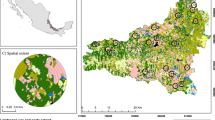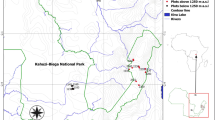Abstract
Changes in species composition and richness across the sub-alpine forest ecotone are well known phenomena. The total number of species at a regional scale drops substantially above the forest-line in the central Himalayas of Nepal. This study tests the effect of a forest border ecotone on a local scale using a grain size of 100 m2. We sampled a set of vertical transects across a sloping sub-alpine forest line where canopy and temperature covary, and a set of horizontal transects across a forest ecotone where there was no altitudinal difference to eliminate the influence of temperature. Detrended correspondence analysis revealed a continuous change in species composition across the forest border ecotone. Species turnover was, in general, low, and species richness did not vary very much between the forest and open landscapes. We attribute this to the grazing and browsing pressure in the area, which may have lowered the tree line. A reduced tree line compared to the climatic limit may facilitate enhanced species richness above the forest line. There was no significant difference in species richness between forest and open landscapes along horizontal transects where temperature variations were minimized. This study exemplifies the difficulties encountered on a local scale when one aims to test diversity hypotheses deduced from general models on forest-ecotone effect and mass effect. The low species turnover and minor differences in alpha diversity may be because the area is a cultural landscape and the homogenizing effect of domestic animals overrides some of the edge effects of the ecotone.






Similar content being viewed by others
References
Alados CL, Aich EL A, Komac B, Pueyo Y, García-Gonzalez R (2007) Self-organized spatial patterns of vegetation in alpine grasslands. Ecol Modelling 201:233–242
Anonymous (1995) Iso-climatic map of mean annual precipitation. ICIMOD / MENRIS, Kathmandu
Anonymous (2005) Climatological records of Nepal 1995–2005. Department of Hydrology and Meteorology, Kathmandu
Archaux F, Gosselin F, Berges L, Chevalier R (2006) Effects of sampling time, species richness and observer on the exhaustiveness of plant censuses. J Veg Sci 17:299–306
Armand A. (1992) Sharp and gradual mountain timberlines as result of species interaction. In Hansen AJ, di Castri F (eds) Landscape boundaries: Consequences for biotic diversity and ecological flows. Ecological Studies 92, Springer, Berlin, pp 360–378
Auerbach M, Shmida A (1993) Vegetation change along an altitudinal gradient on Mt. Hermon, Israel – no evidence for discrete communities. J Ecol 81:25–33
Austin MP (2005) Vegetation and environment: discontinuities and continuities. In van der Maarel E (ed) Vegetation ecology. Blackwell Publishing, Oxford, pp 52–84
Bhattarai KR, Vetaas OR (2003) Variation in plant species richness of different life forms along a subtropical elevation gradient in the Himalayas, east Nepal. Global Ecol Biogeogr 12:327–340
Camarero JJ, Gutierrez E, Fortin M (2006) Spatial pattern of plant richness across tree line ecotones in the Pyrenees reveal different locations for richness and tree cover boundaries. Global Ecol Biogeogr 15:182–191
Castro J, Zamora R, Hódar JA, Gómez JM (2002) Use of shrubs as nurse plants: a new technique for restoration in Mediterranean mountains. Restoration Ecol 10:297–305
Dobson AJ (2002) An introduction to generalized linear models. Ed. 2. Chapman and Hall, London
Ellenberg H, Weber HE, Dull R, Wirth V, Werner W, Paulißen D (1991) Zeigenwerte von Pflanzen in Mitteleuropa. Scripta Geobot 18:1–248
Fuentes ER, Otaiza RD, Alliende MC, Hoffman AJ, Poiani A (1984) Shrub clumps of the Chilean matorral vegetation: structure and possible maintenance mechanisms. Oecologia 62:405–411
Germino MJ., Smith WK, Resor A.C (2002) Conifer seedling distribution and survival in an alpine treeline ecotone. Pl Ecol 162:157–168
Grytnes JA (2003) Species-richness of vascular plants along seven altitudinal transects in Norway. Ecography 26:291–300
Grytnes JA, Vetaas OR (2002) Species richness and altitude: A comparison between null models and interpolated plant species richness along the Himalayan altitudinal gradient, Nepal. Amer Naturalist 159:294–304
Grytnes JA, Heegaard E, Ihlen PG (2006) Species richness of vascular plants, bryophytes, and lichens along an altitudinal gradient in western Norway. Acta Geol 29:241–246
Hadley JL, Smith WK (1987) Influence of Krummholz mat microclimate on needle physiology and survival. Oecologia 73:82–90
Hagen T (1969) Report on Geological Survey of Nepal. Denkschr Schweiz Naturf Ges 86:1–185
Hara H, Williams HJ (1979) An enumeration of the flowering plants of Nepal II. British Museum Natural History, London
Hara H, Williams HJ (1982) An enumeration of the flowering plants of Nepal III. British Museum Natural History, London
Hara H, Stearn WT, Williams HJ (1978) An enumeration of the flowering plants of Nepal I. British Museum Natural History, London
Hastie TJ, Tibshirani RJ (1990) Generalized additive models. Chapman & Hall, London
Hastie TJ, Pregibon D (1993) Generalized Linear Models. In Chambers JM, Hastie TJ (eds) Statistical models. Chapman & Hall, London, pp 195–247
Hill MO, Gauch HG (1980) Detrended correspondence analysis: an improved ordination technique. Vegetatio 42:47–58
Hofgaard A (1997) Inter-relationships between tree line position, species diversity, and land use and climate change, in the central Scandes Mountain of Norway. Global Ecol Biogeogr Lett 6:419–429
Hofgaard A, Willmann B (2002) Plant distribution pattern across the forest-tundra ecotone: The importance of tree line position. Ecoscience 9:375–385
Kitayama K (1992) An altitudinal transect study of the vegetation on Mount Kinabalu, Borneo. Vegetatio 102:149–171
Kitzberger T, Steinaker DF, Veblen TT (2000) Effect of climatic variability on facilitation of tree establishment in northern Patagonia. Ecology 81:1914–1924
Joel F, Enrique J (2003) Are nurse protégé interactions more common among plants from arid environments? J Veg Sci 14:911–916
Klimeš L, Dančák M, Hájek M, Jongepierová I, Kučera T (2001) Scale-dependent biases in species counts in a grassland. J Veg Sci 12:699–704
Körner C (1999) Alpine plant life: Functional plant ecology of high mountain ecosystems. Springer Verlag, Berlin
Kullman L (1993) Tree-limit dynamics of Betula pubescens ssp. tortuousa in relation to climate variability: evidence from central Sweden. J Veg Sci 4:765–772
Kullman L (1998) Tree limits and montane forests in Scandes: sensitive biomonitors of climate change and variability. Ambio 27:312–321
Kullman L (2000) Tree limits and recent warming: a geological case study from the Swedish Scandes. Norsk Geogr Tidsskr 54:49–59
Legendre P, Legendre L (1998) Numerical ecology. Ed. 2. Elsevier, Amsterdam
Lomolino MV (2001) Elevation gradients of species density: historical and prospective views. Global Ecol Biogeogr 10:3–13
Łuczaj Ł. & Sadowska B. (1997) Edge effect in different groups of organism: vascular plant, bryophyte and fungi species richness across forest landscape border. Folia Geobot Phytotax 32:343–353
McCullagh P, Nelder JA (1989) Generalized linear model. Ed. 2. Chapman & Hall, London
Miehe G (1982) Vegetations geographische Untersuchungen im Dhaulagiri in Annapurna-Himalaya. Dissertationes Botanicæ 66. J. Cramer, Vaduz
Moquet N, Loreau M (2003) Community patterns in source-sink metacommunities. Amer Naturalist 162:544–557
O’Brien EM (2006) Biological relativity to water-energy dynamics. J Biogeogr 33:1868–1888
Odland A (1996) Differences in the vertical distribution pattern of Betula pubescens in Norway and its ecological significance. Palaeoclimate Res 20:43–59
Odland A, Birks HJB (1999) The altitudinal gradient of vascular plant richness in Aurland, western Norway. Ecography 22:548–566
Oke TR (1987) Boundary layers climate. Ed. 2. Methuen & Co, New York
Økland RH, Bendiksen E (1985) The vegetation of forest-alpine transition in the Grunningsdalen area, Telemark, SE Norway. Sommerfeltia 2:1–224
Press JR, Shrestha KK, Sutton DA (2000) Annotated checklist of the flowering plants of Nepal. The Natural History Museum, London
Quinn G, Keough MJ (2002) Experimental design and data analysis for biologists. Cambridge University Press, Cambridge
R Development Core Team (2008) R: A language and environment for statistical computing. R Foundation for Statistical Computing, Vienna. Available at: http://www.r-project.org/
Shmida A, Wilson MW (1985) Biological determinants of species diversity. J Biogeogr 12:1–20
Stainton JDA (1972) Forests of Nepal. John Murray Ltd., London
Stevens GC (1992) The elevation gradient in altitudinal range: an extension of rappoport’s latitudinal rule to altitude. Amer Naturalist 140:893–911
ter Braak CJF, Prentice IC (1988) A theory of gradient analysis. Advances Ecol Res 18:271–317
ter Braak CJF, Šmilauer P (1998) CANOCO reference manual and user’s guide to Canoco for Windows: software for canonical community ordination version 4. Micro computer Power, Ithaca
ter Braak CJF, Šmilauer P (2002) Canoco for Windows version 4.5. Biometrics-Plant Research International, Wageningen
van der Maarel E (1990) Ecotone and ecoclines are different. J Veg Sci 1:135–138
Vandvik V, Heegaard E, Måren IE, Aarrestad PA (2005) Managing heterogeneity: the importance of grazing and environmental variation on post-fire succession in heathlands. J Appl Ecol 42:139–149
Vetaas OR (2006) Biological relativity to water-energy dynamics: a potential unifying theory? J Biogeogr 33:1866–1867
Vetaas OR, Grytnes JA (2002) Distribution of vascular plants species richness and endemic richness along the Himalayan elevation gradient in Nepal. Global Ecol Biogeogr 11:291–301
Acknowledgements
We thank Shishir Poudel and Narayan Shrestha for accompanying us during the field work. We are grateful to Prof. John Birks and other members of Environmental and Ecological Change Research Group (EECRG) for constructive comments on early drafts of this paper. Annapurna Conservation Area Project (ACAP) is acknowledged for permission to undertake field work. State Education Loan Fund (Lånekassen), The Faculty of Mathematics and Natural Science at the University of Bergen supported fieldwork for both the authors. Cathy Jenks is acknowledged for improvement of the language.
Author information
Authors and Affiliations
Corresponding author
Appendix 1
Appendix 1
Species names and abbreviations used in Fig. 3
Nr. | Full name of the species | Species Abbreviation |
1 | Anaphalis cuneifolia | Anap cun |
2 | Androsace sp. | Andr sp. |
3 | Androsace strigillosa | Andr str |
4 | Aster himalaicus | Aste him |
5 | Aster indamellus (A. pseudamellus) | Aste ind |
6 | Astragalus rhizanthus | Astr rhi |
7 | Berberis aristata var. floribunda | Berb ari |
8 | Berberis concinna | Berb con |
9 | Bupleurum tenue | Bupl ten |
10 | Carex sp. | Care sp. |
11 | Cotoneaster microphyllus | Coto mic |
12 | Cotoneaster sp. | Coto sp. |
13 | Gentiana robusta | Gent rob |
14 | Juniperus indica | Juni ind |
15 | Juniperus squamata | Juni squ |
16 | Lactuca lessertiana | Lact les |
17 | Lonicera myrtillus | Loni myr |
18 | Pinus wallichiana | Pinu wal |
19 | Polygonatum cirrhifolium | Poly cir |
20 | Selinum tenuifolium | Seli ten |
21 | Spiraea arcuata | Spir arc |
22 | Stellera chamaejasme | Stel cam |
23 | Stipa sp. | Stip sp.1 |
24 | Tanacetum nubigenum | Tana nub |
25 | Thalictrum foetidum | Thal foe |
26 | Thymus linearis | Thym lin |
27 | Trigonella emodi | Trig emo |
Rights and permissions
About this article
Cite this article
Shrestha, K.B., Vetaas, O.R. The Forest Ecotone Effect on Species Richness in an Arid Trans-Himalayan Landscape of Nepal. Folia Geobot 44, 247–262 (2009). https://doi.org/10.1007/s12224-009-9046-9
Received:
Revised:
Accepted:
Published:
Issue Date:
DOI: https://doi.org/10.1007/s12224-009-9046-9




